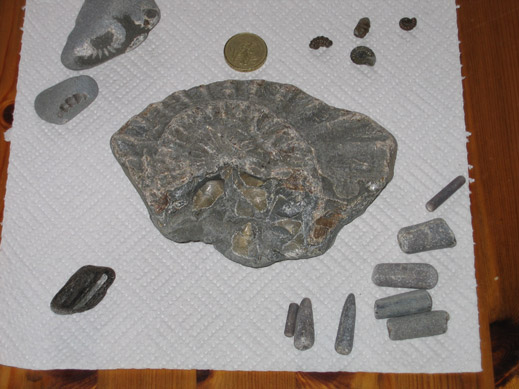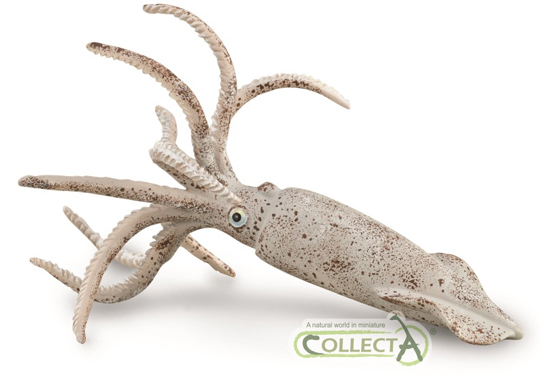Fossil Finds from Charmouth Beach
It is always a pleasure to visit the Dorset coast and meet up with some of our fossil hunting friends. We had some fun over the Bank holiday weekend ending our fossil hunting trip on Charmouth beach on the Monday and despite the rain we were able to visit the belemnite beds adjacent to the Heritage centre and find plenty of specimens for use in our various school projects and classroom exercises.
Fossil Finds
Some of the samples we found are shown below, with a £1 coin shown for scale. On the top right of the picture there are some examples of the pyritised ammonites from the foreshore in front of the Black Ven Marl from the Charmouth Mudstone Formation. These little ammonites are locally known as “Proms” as they are from the genus Promicroceras. In the centre there are the remnants of a partially calcified larger ammonite and at the bottom there are a range of belemnite guards, including some nice “arrows”, the pointed ones that represent the rear portion of this part of the animal’s internal skeleton.
A Selection of Fossils from Charmouth

Picture credit: Everything Dinosaur
Fossil Bone
In the bottom left of the picture there is a shiny, glossy black object. This is a piece of fossil bone found by an Everything Dinosaur team member below the Black Ven Marl sediments amongst the pebbles and rocks on the beach. The cavities that make up this type of bone (cancellous bone), otherwise known as “spongy bone” can still be clearly seen. Fragments of fossil bone such as this piece are quite common on Charmouth beach, over the 3 days that we were in the area, Everything Dinosaur team members found several pieces. All have been heavily eroded and it is impossible to relate these finds to any particular genus but it is likely they are fragments of ichthyosaur. These marine reptiles are more common as fossils compared to plesiosaurs for example, but due to the highly eroded nature of the finds, it is not possible to identify these fossils accurately.
A Replica of a Jurassic Belemnite
Finding Fossils
Bone fossils are notoriously difficult to spot. Sitting about the Blue Lias sediments at Lyme Regis (these are the oldest Jurassic rocks exposed at Lyme), there is a band of sediments known as Shales with Beef. These rocks are so called as they have a marble pattern to them. In cross section they look like fossilised pieces of meat. It can be quite hard to distinguish between these shales and real fossil bone when scouring the foreshore.
Everything Dinosaur stocks a wide range of replicas of marine reptiles such as plesiosaurs and ichthyosaurs: Prehistoric Marine Reptiles and Sea Monsters.
To help some of our team members “get their eye in” as it were, we carry fossil bones that we had found on the beach on previous visits. We can use these as a quick reference when examining other potential fossil bones. These fossils look very different when wet, sometimes as an aid to finding more pieces one of our team members will dip a bone fragment into a nearby rock pool. The fossil seems to come alive, it takes on a much more glossy, black and shiny appearance which makes them much more distinctive then the grey, dull shales with beef. This to can provide a useful reference for those team members not yet used to telling the difference between the fossil bone and the other, numerous types of pebbles to be found on the beach.
Everything Dinosaur stocks a wide range of replicas of iconic animals from the fossil record such as ammonites and belemnites. You can view them here: Ammonite and Belemnite Models.
I quick examination with one of our trusty magnifying lenses (we carry 6x and 10x lenses on most trips) and that should just about confirm the piece’s identification. One thing that we do keep forgetting to bring with us is our knee-pads, it can be quite uncomfortable getting down onto all fours to scramble around looking for these relatively small fossils.







Leave A Comment